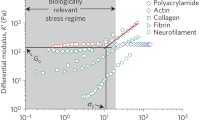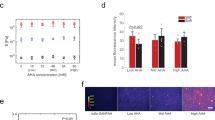Abstract
Stiffness gradient hydrogels are a useful platform for studying mechanical interactions between cells and their surrounding environments. Here, we developed linear stiffness gradient hydrogels by controlling the polymerization of gelatin methacryloyl (GelMA) via differential UV penetration with a gradient photomask. Based on previous observations, a stiffness gradient GelMA hydrogel was created ranging from ~ 4 to 13 kPa over 15 mm (0.68 kPa/mm), covering the range of physiological tissue stiffness from fat to muscle, thereby allowing us to study stem cell mechanosensation and differentiation. Adipose-derived stem cells on these gradient hydrogels showed no durotaxis, which allowed for the screening of mechanomarker expression without confounding directed migration effects. In terms of morphological markers, the cell aspect ratio showed a clear positive correlation to the underlying substrate stiffness, while no significant correlation was found in cell size, nuclear size, or nuclear aspect ratio. Conversely, expression of mechanomarkers (i.e., Lamin A, YAP, and MRTFa) all showed a highly significant correlation to stiffness, which could be disrupted via inhibition of non-muscle myosin or Rho/ROCK signalling. Furthermore, we showed that cells plated on stiffer regions became stiffer themselves, and that stem cells showed stiffness-dependent differentiation to fat or muscle as has been previously reported in the literature.



Similar content being viewed by others
References
Berry, M. F., A. J. Engler, Y. J. Woo, T. J. Pirolli, L. T. Bish, V. Jayasankar, K. J. Morine, T. J. Gardner, D. E. Discher, and H. L. Sweeney. Mesenchymal stem cell injection after myocardial infarction improves myocardial compliance. Am. J. Physiol.-Heart Circ. Physiol. 290(6):H2196–H2203, 2006.
Caliari, S. R., S. L. Vega, M. Kwon, E. M. Soulas, and J. A. Burdick. Dimensionality and spreading influence MSC YAP/TAZ signaling in hydrogel environments. Biomaterials 103:314–323, 2016.
Choi, Y. S., L. G. Vincent, A. R. Lee, M. K. Dobke, and A. J. Engler. Mechanical derivation of functional myotubes from adipose-derived stem cells. Biomaterials 33(8):2482–2491, 2012.
Choi, Y. S., L. G. Vincent, A. R. Lee, K. C. Kretchmer, S. Chirasatitsin, M. K. Dobke, and A. J. Engler. The alignment and fusion assembly of adipose-derived stem cells on mechanically patterned matrices. Biomaterials 33(29):6943–6951, 2012.
Colthup, N., L. Daly, and S. Wiberley. Introduction to Infrared and Raman Spectroscopy (3rd ed.). New York: Academic Press, 1990.
Cross, L. M., K. Shah, S. Palani, C. W. Peak, and A. K. Gaharwar. Gradient nanocomposite hydrogels for interface tissue engineering. Nanomedicine 14(7):2465–2474, 2018.
Discher, D. E., P. Janmey, and Y. L. Wang. Tissue cells feel and respond to the stiffness of their substrate. Science 310(5751):1139–1143, 2005.
Dupont, S., L. Morsut, M. Aragona, E. Enzo, S. Giulitti, M. Cordenonsi, F. Zanconato, J. Le Digabel, M. Forcato, S. Bicciato, N. Elvassore, and S. Piccolo. Role of YAP/TAZ in mechanotransduction. Nature 474(7350):179–183, 2011.
Engler, A. J., S. Sen, H. L. Sweeney, and D. E. Discher. Matrix elasticity directs stem cell lineage specification. Cell 126(4):677–689, 2006.
Hadden, W. J., J. L. Young, A. W. Holle, M. L. McFetridge, D. Y. Kim, P. Wijesinghe, H. Taylor-Weiner, J. H. Wen, A. R. Lee, K. Bieback, B. N. Vo, D. D. Sampson, B. F. Kennedy, J. P. Spatz, A. J. Engler, and Y. S. Choi. Stem cell migration and mechanotransduction on linear stiffness gradient hydrogels. Proc. Natl. Acad. Sci. USA 114(22):5647–5652, 2017.
Happe, C. L., K. P. Tenerelli, A. K. Gromova, F. Kolb, and A. J. Engler. Mechanically patterned neuromuscular junctions-in-a-dish have improved functional maturation. Mol. Biol. Cell 28(14):1950–1958, 2017.
Hartman, C. D., B. C. Isenberg, S. G. Chua, and J. Y. Wong. Vascular smooth muscle cell durotaxis depends on extracellular matrix composition. Proc. Natl. Acad. Sci. USA 113(40):11190–11195, 2016.
Janko, M., A. Zink, A. Gigler, W. Heckl, and R. Stark. Nanostructure and mechanics of mummified type I collagen from the 5300-year-old tyrolean Iceman. Proc. R. Soc. B 277(1692):2301–2309, 2010.
Kang, H., Y. V. Shih, Y. Hwang, C. Wen, V. Rao, T. Seo, and S. Varghese. Mineralized gelatin methacrylate-based matrices induce osteogenic differentiation of human induced pluripotent stem cells. Acta Biomater. 10(12):4961–4970, 2014.
Kloxin, A. M., J. A. Benton, and K. S. Anseth. In situ elasticity modulation with dynamic substrates to direct cell phenotype. Biomaterials 31(1):1–8, 2010.
Kovacs, M., J. Toth, C. Hetenyi, A. Malnasi-Csizmadia, and J. R. Sellers. Mechanism of blebbistatin inhibition of myosin II. J. Biol. Chem. 279(34):35557–35563, 2004.
Kumper, S., and C. J. Marshall. ROCK-driven actomyosin contractility induces tissue stiffness and tumor growth. Cancer Cell 19(6):695–697, 2011.
Lee, H. P., R. Stowers, and O. Chaudhuri. Volume expansion and TRPV4 activation regulate stem cell fate in three-dimensional microenvironments. Nat. Commun. 10(1):529, 2019.
Leijten, J., J. Seo, K. Yue, G. T. Santiago, A. Tamayol, G. U. Ruiz-Esparza, S. R. Shin, R. Sharifi, I. Noshadi, M. M. Alvarez, Y. S. Zhang, and A. Khademhosseini. Spatially and temporally controlled hydrogels for tissue engineering. Mater. Sci. Eng. 119:1–35, 2017.
Major, L. G., A. W. Holle, J. L. Young, M. S. Hepburn, K. Jeong, I. L. Chin, R. W. Sanderson, J. H. Jeong, Z. M. Aman, B. F. Kennedy, Y. Hwang, D. W. Han, H. W. Park, K. L. Guan, J. P. Spatz, and Y. S. Choi. Volume adaptation controls stem cell mechanotransduction. ACS Appl. Mater. Interfaces, 2019.
Miralles, F., G. Posern, A. I. Zaromytidou, and R. Treisman. Actin dynamics control SRF activity by regulation of its coactivator MAL. Cell 113(3):329–342, 2003.
Nardone, G., J. Oliver-De La Cruz, J. Vrbsky, C. Martini, J. Pribyl, P. Skladal, M. Pesl, G. Caluori, S. Pagliari, F. Martino, Z. Maceckova, M. Hajduch, A. Sanz-Garcia, N. M. Pugno, G. B. Stokin, and G. Forte. YAP regulates cell mechanics by controlling focal adhesion assembly. Nat. Commun. 8:15321, 2017.
O’Connell, C. D., B. Zhang, C. Onofrillo, S. Duchi, R. Blanchard, A. Quigley, J. Bourke, S. Gambhir, R. Kapsa, C. Di Bella, P. Choong, and G. G. Wallace. Tailoring the mechanical properties of gelatin methacryloyl hydrogels through manipulation of the photocrosslinking conditions. Soft Matter 14(11):2142–2151, 2018.
Piraino, F., G. Camci-Unal, M. J. Hancock, M. Rasponi, and A. Khademhosseini. Multi-gradient hydrogels produced layer by layer with capillary flow and crosslinking in open microchannels. Lab Chip 12(3):659–661, 2012.
Reilly, G. C., and A. J. Engler. Intrinsic extracellular matrix properties regulate stem cell differentiation. J. Biomech. 43(1):55–62, 2010.
Stiles, P., J. Dieringer, and N. Shah. Surface-enhanced raman spectroscopy. Annu. Rev. Anal. Chem. 1:601–626, 2008.
Swift, J., I. L. Ivanovska, A. Buxboim, T. Harada, P. C. Dingal, J. Pinter, J. D. Pajerowski, K. R. Spinler, J. W. Shin, M. Tewari, F. Rehfeldt, D. W. Speicher, and D. E. Discher. Nuclear lamin-A scales with tissue stiffness and enhances matrix-directed differentiation. Science 341(6149):1240104, 2013.
Tse, J. R., and A. J. Engler. Stiffness gradients mimicking in vivo tissue variation regulate mesenchymal stem cell fate. PLoS ONE 6(1):e15978, 2011.
Vincent, L. G., Y. S. Choi, B. Alonso-Latorre, J. C. del Alamo, and A. J. Engler. Mesenchymal stem cell durotaxis depends on substrate stiffness gradient strength. Biotechnol. J. 8(4):472–484, 2013.
Yu, O. M., S. Miyamoto, and J. H. Brown. Myocardin-related transcription factor A and Yes-associated protein exert dual control in G protein-coupled receptor- and RhoA-mediated transcriptional regulation and cell proliferation. Mol. Cell. Biol. 36(1):39–49, 2015.
Yu, O. M., S. Miyamoto, and J. H. Brown. Myocardin-related transcription factor A and Yes-associated protein exert dual control in G protein-coupled receptor- and RhoA-mediated transcriptional regulation and cell proliferation. Mol. Cell. Biol. 36(1):39–49, 2016.
Acknowledgments
This study work was supported by National Health and Medical Research Council Grant PG1098449 (to YSC), Heart Foundation Future Leader Fellowship 101173 (to YSC), Department of Health, Western Australia, Merit awards—Project and fellowship (to YSC), and Universities Australia DAAD German Research Cooperation 5744610 (to YSC, CK, AWH, JLY and JPS).
Author information
Authors and Affiliations
Contributions
CK, LGM and YSC designed and planned the study. JLY, AWH, and JPS performed SEM and pore size analysis. KJ and ZMA performed Raman spectroscopy. JHJ, YH and DWH synthesized GelMA. CK, JLY and YSC drafted the manuscript. YSC provided supervision and funding. All authors discussed the data and contributed to the final version of the manuscript.
Corresponding author
Additional information
Associate Editor Kent Leach oversaw the review of this article.
Publisher's Note
Springer Nature remains neutral with regard to jurisdictional claims in published maps and institutional affiliations.
Electronic supplementary material
Below is the link to the electronic supplementary material.
Rights and permissions
About this article
Cite this article
Kim, C., Young, J.L., Holle, A.W. et al. Stem Cell Mechanosensation on Gelatin Methacryloyl (GelMA) Stiffness Gradient Hydrogels. Ann Biomed Eng 48, 893–902 (2020). https://doi.org/10.1007/s10439-019-02428-5
Received:
Accepted:
Published:
Issue Date:
DOI: https://doi.org/10.1007/s10439-019-02428-5




